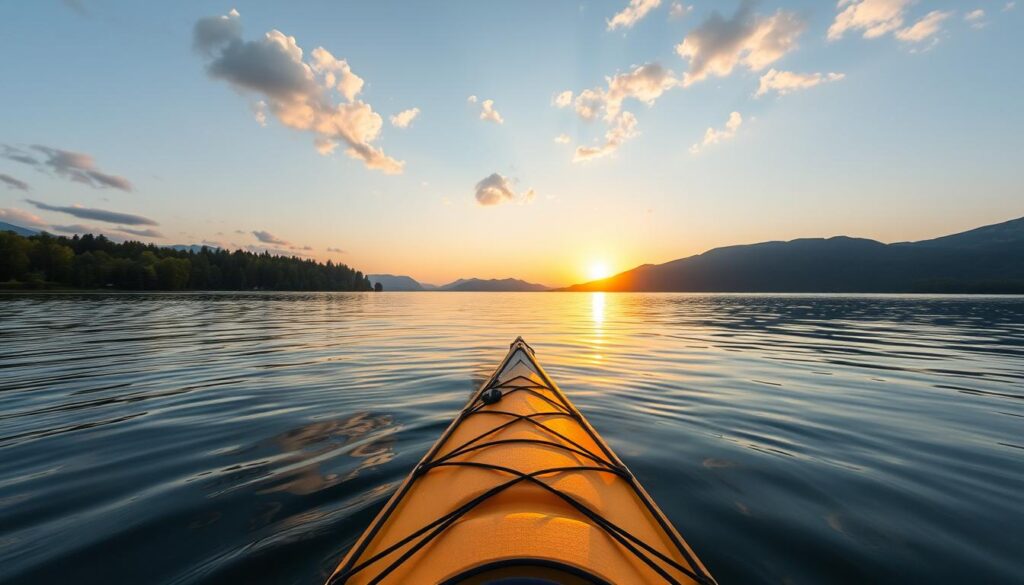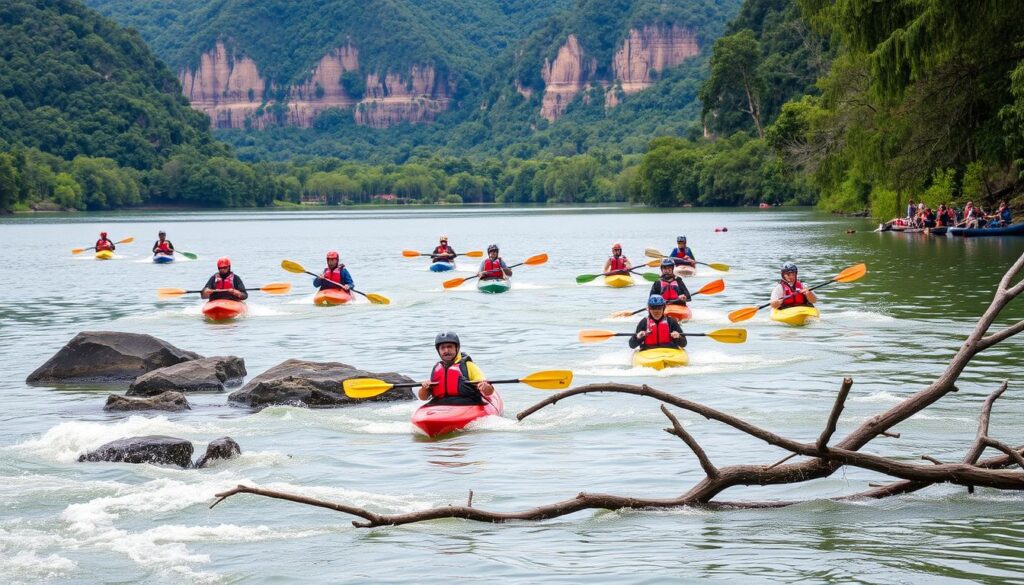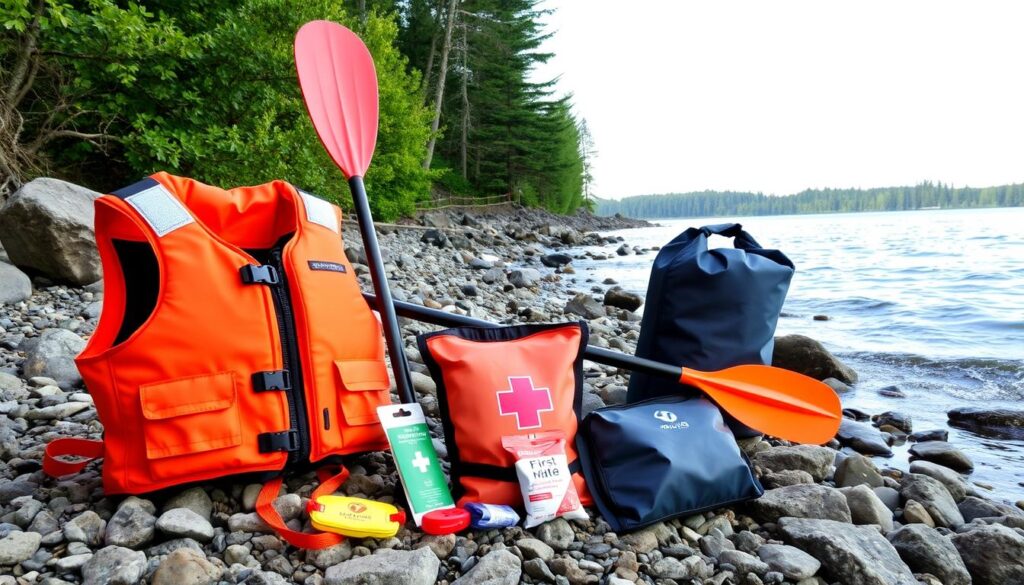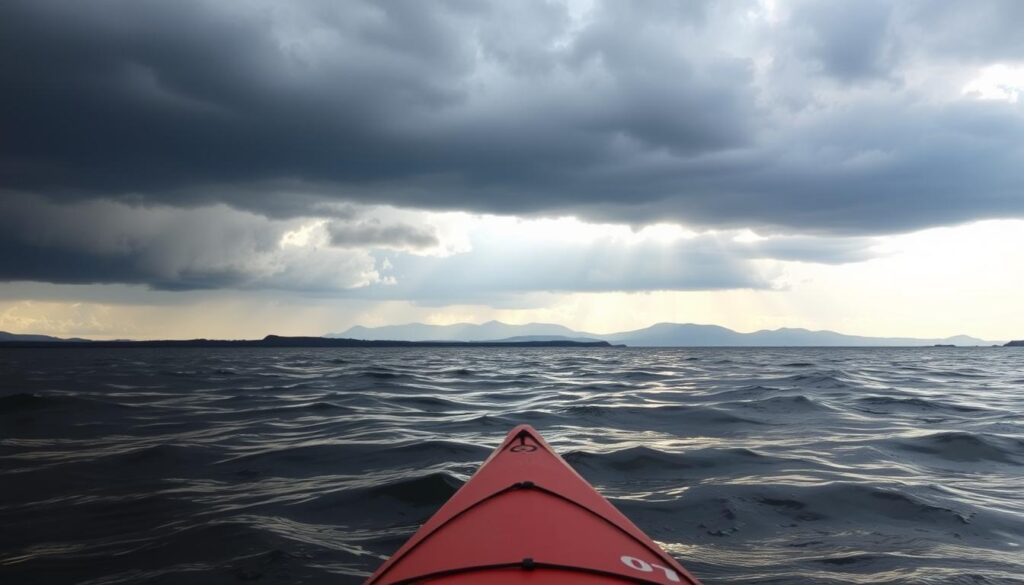- Key Takeaways
- Understanding Common Hazards of Kayaking
- Essential Safety Equipment for Kayaking
- Weather Conditions That Impact Kayak Safety
- Proper Kayak Navigation Techniques
- River Rapids Classification and Safety
- Ocean Kayaking Safety Guidelines
- Preventing and Responding to Capsizing
- Physical Preparation and Injury Prevention
- Communication and Emergency Protocols
- Group Kayaking Safety Measures
- Night Kayaking Precautions
- Conclusion
- FAQ
- What are the most critical safety considerations for kayaking?
- How dangerous are river rapids for kayakers?
- What essential gear should I bring for a kayaking trip?
- How do weather conditions impact kayaking safety?
- What should I do if my kayak capsizes?
- Are there different safety considerations for ocean kayaking?
- How can I prevent kayaking injuries?
- What communication devices are recommended for kayaking?
- How do I prepare for night kayaking?
- What wildlife encounters should kayakers be prepared for?

Kayaking is an exciting way to see water environments. But, it’s important to know the dangers of kayaking to stay safe. Whether you’re new or experienced, knowing how to handle risks is key.
Staying safe while kayaking means being well-prepared and aware of dangers. The water, your gear, and your skills all matter. Learning to avoid risks will make your trip memorable and safe.
Every kayaking trip needs careful planning and respect for nature. Experts say it’s crucial to know the local water, check the weather, and bring the right safety gear. This way, you’re ready for anything.
Key Takeaways
- Always assess water conditions before launching
- Invest in high-quality safety equipment
- Learn basic water rescue techniques
- Check weather forecasts thoroughly
- Develop strong paddling skills through practice
Understanding Common Hazards of Kayaking
Kayaking is an exciting outdoor activity, but knowing the dangers is key to staying safe. Each river and waterway has its own challenges. These can quickly turn a calm trip into a risky situation.

Being ready for potential risks can save you from a bad experience. Let’s look at the dangers you might face while kayaking.
Natural Water Obstacles
Many dangers come from natural water features. Kayakers need to watch out for several key obstacles:
- Submerged rocks that can cause sudden capsizing
- Unexpected underwater logs and fallen trees
- Sudden depth changes and underwater currents
- Narrow channel passages with increased water velocity
Man-made Hazards
Human-made structures can also be risky for kayakers. Be cautious of these dangers:
- Low-hanging bridges with strong water currents
- Fishing lines and recreational boat traffic
- Dam releases and water control structures
- Abandoned infrastructure near waterways
Wildlife Encounters
Wildlife can surprise you during your kayaking trip. Some possible encounters include:
- Territorial animals near water edges
- Potential aggressive marine life
- Nesting birds and protective parent animals
- Unexpected underwater creatures
Knowing these hazards helps you make safer choices. This way, you can enjoy your water adventures more.
Essential Safety Equipment for Kayaking
Having the right gear is key to safe kayaking. It’s not just about accessories; it’s about lifesaving tools. These tools protect you while you’re on the water.

Your safety kit should have important items. These items help protect and support you in emergencies. Knowing what to pack can lower your risk on the water.
- Personal Flotation Device (PFD)
- Waterproof communication device
- First aid kit
- Emergency whistle
- Protective headgear
Choosing the right PFD is vital. Look for a PFD made for kayaking. It should be comfortable and allow for easy movement while keeping you safe.
| Equipment | Purpose | Recommended Type |
|---|---|---|
| PFD | Flotation and safety | Type III kayaking vest |
| Helmet | Head protection | Whitewater-specific model |
| Whistle | Emergency signaling | Marine-grade loud whistle |
“Preparation is the key to safe kayaking. Never underestimate the importance of proper safety equipment.” – Professional Kayak Instructor
More safety tips include carrying a waterproof bag with emergency items. Also, have a throw bag for rescue and wear clothes that protect against water and cold.
Invest in quality gear that’s made for water activities. Make sure to check your equipment before each trip. This will keep you safe on every kayaking adventure.
Weather Conditions That Impact Kayak Safety
Kayaking fans know weather is key for a safe and fun time on the water. Knowing about kayak weather hazards can turn a great trip into a safe one.

Start your kayaking safety by checking the weather first. Paddlers know water can change fast, so planning ahead is vital.
Wind and Wave Patterns
Wind is a big deal for kayaking safety. Strong winds make the water hard to navigate, even for pros. Here are some wind tips:
- Wind over 15 mph raises kayaking risks
- Crosswinds can steer kayaks off course
- Wave size affects how hard it is to paddle
Storm Preparedness
Storms can be a big danger for kayakers. Knowing weather signs and having a backup plan is key.
“The sky tells a story – learn to read its language before you hit the water.” – Professional Kayaking Instructor
Temperature Considerations
Water temperature is as important as wind. Hypothermia is a big risk, especially in cold areas.
| Water Temp (°F) | Risk Level | Recommended Gear |
|---|---|---|
| Above 70 | Low Risk | Standard PFD |
| 50-70 | Moderate Risk | Wetsuit |
| Below 50 | High Risk | Drysuit, thermal layers |
Always check local weather, know the water, and pack the right safety gear to avoid kayak weather hazards.
Proper Kayak Navigation Techniques
Learning to navigate a kayak safely is key. It involves understanding water currents and how to position your kayak. This knowledge helps avoid dangers and makes your trip smoother.
Good kayak navigation needs skills and awareness. Here are some tips for safe navigation:
- Analyze water flow and current direction before paddling
- Use forward sweep strokes to change kayak direction quickly
- Maintain a low center of gravity for better stability
“The best kayakers don’t fight the water – they work with it.” – Professional Kayaking Instructor
Your paddle technique is vital in different water conditions. Adjust your grip and stroke for the current’s speed and direction. This reduces risks and improves control.
Advanced paddlers suggest staying alert to your surroundings. Look out for: • Submerged rocks • Unexpected water currents • Changing water levels • Wind patterns
Start with calm waters and practice these techniques. Regular training boosts your confidence and skills in various kayaking situations.
River Rapids Classification and Safety
Navigating river rapids needs skill, knowledge, and respect for the water’s power. It’s key for kayaking safety and a fun, safe trip.
River rapids are divided into six grades, each with its own challenges. Knowing these grades helps you get ready and choose the right kayaking route.
Understanding Rapids Grades
- Class I: Easy rapids with small waves and few obstructions
- Class II: Slightly more challenging with moderate waves
- Class III: Substantial rapids requiring significant maneuvering skills
- Class IV: Advanced rapids with powerful water and complex routes
- Class V: Extremely difficult with serious risk
- Class VI: Essentially unrunnable with extreme danger
Rapid Navigation Strategies
Successful river rapids navigation needs precise techniques. Always scout your route, spot potential hazards, and plan your approach. Keep a balanced body position and use strong, deliberate paddle strokes.
Emergency Maneuvers
Be ready for unexpected situations by learning critical rescue techniques. Know how to perform self-rescue, read water currents, and quickly respond to safety challenges.
“Knowledge and preparation are your best defense against river rapids dangers.” – Professional Kayaking Instructor
| Rapids Grade | Difficulty Level | Recommended Experience |
|---|---|---|
| Class I-II | Beginner | Minimal kayaking experience |
| Class III | Intermediate | Some whitewater experience |
| Class IV-V | Advanced | Extensive whitewater skills |
| Class VI | Expert | Professional level training |
Ocean Kayaking Safety Guidelines
Ocean kayaking is full of challenges that need careful planning and skills. It’s important to know the risks to have a safe and fun time on the water. Kayakers need special knowledge and gear for coastal waters, unlike freshwater paddling.
“The ocean demands respect and preparation from every kayaker.” – Professional Marine Instructor
When kayaking in the ocean, you must plan well and assess risks. The ocean’s conditions can change fast, so staying alert is key.
- Check marine weather forecasts before launching
- Understand local tide and current patterns
- Wear appropriate maritime safety gear
- Carry marine communication devices
- Develop strong paddling skills
Knowing how to navigate is crucial for ocean kayaking. You need to understand coastal rules and marine traffic to stay safe.
| Ocean Kayaking Risk Factor | Recommended Preparation |
|---|---|
| Unpredictable Wind Conditions | Check wind speed and direction before departure |
| Strong Ocean Currents | Study local maritime current maps |
| Wave Height Variations | Learn wave reading and navigation techniques |
| Potential Marine Wildlife Interactions | Understand local marine ecosystem behaviors |
Experts say getting advanced training for ocean kayaking is a must. Getting proper education greatly lowers risks and boosts safety.
Preventing and Responding to Capsizing
Kayak capsizing can happen to anyone, even experienced paddlers. Knowing how to prevent and handle a capsize is key to staying safe. Learning kayak rescue techniques is vital for avoiding serious issues.
The risk of capsizing depends on the water, kayak, and your skill level. Being prepared and knowing what to do can save you in emergencies.
Self-Rescue Techniques
Preventing capsizing starts with good habits. Here are some ways to lower your risk:
- Maintain proper balance and body positioning
- Practice bracing techniques
- Understand your kayak’s stability characteristics
- Wear appropriate safety gear
Emergency Rescue Procedures
If you do capsize, act quickly and stay calm. Learn these basic rescue steps:
- Stay calm and assess the situation
- Hold onto your paddle and kayak
- Perform a wet exit if necessary
- Attempt to re-enter the kayak using learned methods
“Preparation turns potential disaster into manageable challenge.” – Kayaking Safety Expert
| Rescue Technique | Difficulty Level | Practice Recommended |
|---|---|---|
| Eskimo Roll | Advanced | Extensive training required |
| Paddle Float Rescue | Intermediate | Regular practice suggested |
| Cowboy Rescue | Advanced | Professional instruction recommended |
Remember, mastering kayak rescue techniques takes time and consistent practice. Always paddle with a buddy and never underestimate the importance of proper training.
Physical Preparation and Injury Prevention
Getting your body ready for kayaking is key to avoiding injuries and having fun. Knowing the physical needs of this sport is the first step.
Your workout should target specific muscles and improve your overall fitness. Focus on:
- Core strength for stability
- Upper body endurance
- Shoulder and arm muscle conditioning
- Cardiovascular fitness
“Proper physical preparation is your first line of defense against kayaking injuries.” – Professional Kayaking Instructor
To lower injury risks, add these exercises to your routine:
- Rotational core exercises
- Resistance band shoulder workouts
- Paddling-specific strength training
- Flexibility and stretching routines
Knowing your limits is crucial for kayaking safety. Experts suggest a detailed fitness plan:
| Fitness Area | Recommended Focus | Injury Prevention Benefit |
|---|---|---|
| Cardiovascular | Swimming, Running | Enhanced endurance |
| Strength | Weight Training | Muscle resilience |
| Flexibility | Yoga, Stretching | Reduced muscle strain |
Remember, consistent training and proper technique are your best defenses against potential kayaking injuries.
Communication and Emergency Protocols
Kayaking safety is all about good communication and emergency plans. When you’re on the water, a solid plan can turn a small problem into a big one.
Being prepared for kayaking means knowing how to signal for help. It also means staying connected in remote places. Your safety depends on clear communication and quick actions.
Critical Distress Signals
Kayakers need to know several ways to signal for help in emergencies:
- Three loud whistle blasts (universal distress signal)
- Waving arms in an X formation
- Bright colored clothing or emergency flag
- Flashing light or strobe device
Emergency Contact Planning
Having a good emergency contact plan is key for kayaking safety. Your plan should include:
- Personal locator beacon (PLB) or satellite communication device
- Emergency contact numbers
- Local rescue coordination information
“Preparation is the best protection when kayaking in unpredictable environments.”
Being prepared for kayaking means thinking ahead and having backup plans. Always carry waterproof communication devices. Know how to use them well.
Group Kayaking Safety Measures
Group kayaking comes with its own set of challenges. It needs careful planning and teamwork. Good communication and group dynamics are key to safety.
“Teamwork is the key to survival on the water” – Professional Kayaking Instructor
Here are some key safety tips for group kayaking:
- Use a buddy system to keep everyone together
- Make sure everyone knows how to communicate
- Have a safety talk before you start
Knowing everyone’s skill level is important. Form a group that keeps beginners safe. Experienced paddlers can help when needed.
| Group Position | Responsibility | Safety Role |
|---|---|---|
| Lead Kayaker | Navigation | Scout potential hazards |
| Middle Kayakers | Group Support | Maintain group cohesion |
| Rear Kayaker | Group Monitoring | Assist any struggling paddlers |
Being ready for emergencies is crucial. Have a plan for:
- How to rescue someone who has tipped over
- How to communicate in an emergency
- First aid and fixing equipment
Focus on teamwork and safety to make your kayaking trip safe and fun.
Night Kayaking Precautions
Kayaking at night comes with its own set of challenges. You need to know how to stay safe and what gear to bring. This ensures a fun and safe night on the water.
Essential Visibility Requirements
When it’s dark, seeing and being seen is key. You’ll need the right safety gear:
- 360-degree visibility beacon
- Reflective tape on paddle and kayak
- Headlamp with multiple brightness settings
Navigating Safely After Dark
Night kayaking means you need to be extra careful and plan ahead. Here’s what to do:
- Familiarize yourself with the water route during daylight
- Check weather conditions before departure
- Inform someone about your planned route and expected return time
“Night kayaking isn’t about adventure—it’s about intelligent preparation and respect for the water.”
Always remember, safety is about being seen and seeing others. Make sure to check your gear and stay alert after sunset.
Conclusion
Kayaking is an amazing adventure, but knowing the dangers is key to staying safe. You need to prepare well, learn about the water, and respect nature. By following the tips in this guide, you’ll be ready to face different waters with confidence.
Kayaking safety is more than just gear or skills. It’s about being physically ready, aware of your surroundings, and always learning. No matter where you paddle, always pay attention and plan ahead. With the right training, gear, and knowledge, kayaking can be a fun and safe activity.
Your safety is always the top priority. Learn rescue skills, know the local water, and build strong kayaking skills. By being dedicated to learning and safe adventures, every trip will be exciting and memorable.
Keep a mindset of respect for nature, being prepared, and always learning. The more you know about kayaking dangers, the more you’ll enjoy exploring waterways in the U.S. and beyond.
FAQ
What are the most critical safety considerations for kayaking?
Key safety tips include wearing a life jacket and checking the weather. Carry essential gear and know the water conditions. Also, have rescue skills and tell someone your route and return time. Never kayak alone if you’re new.
How dangerous are river rapids for kayakers?
River rapids are very dangerous, especially for beginners. Rapids range from Class I (easy) to Class VI (extreme). Risks include underwater obstacles and strong currents. It’s crucial to know how to navigate them safely.
What essential gear should I bring for a kayaking trip?
You’ll need a PFD, helmet, and a waterproof first aid kit. Don’t forget an emergency whistle, paddle float, and bilge pump. Also, bring dry bags, a communication device, and a rescue throw bag. Wear the right clothes and have a map or GPS.
How do weather conditions impact kayaking safety?
Weather greatly affects kayaking safety. Wind and waves can make paddling hard. Storms can change water levels quickly, leading to hypothermia. Always check the weather and be ready to cancel if it’s bad.
What should I do if my kayak capsizes?
If your kayak flips, stay calm. Hold onto your paddle and kayak. Try to get to the nearest shore. Use a paddle float rescue or eskimo roll if you know how. If not, signal for help and stay with your kayak.
Are there different safety considerations for ocean kayaking?
Ocean kayaking has its own dangers. You’ll face unpredictable tides and stronger currents. Wear marine safety gear and know how to navigate. Be ready for quick weather changes.
How can I prevent kayaking injuries?
To avoid injuries, paddle correctly and do strength training. Use ergonomic gear and wear protective clothing. Stay hydrated and build your skills slowly. Warm up before paddling and listen to your body.
What communication devices are recommended for kayaking?
Use waterproof phones, marine VHF radios, and personal locator beacons (PLBs). Choose the right devices for your area and make sure they’re waterproof. Always have a backup plan for communication.
How do I prepare for night kayaking?
For night paddling, use white lights and reflective clothes. Carry extra lights and know the area well. Travel with experienced paddlers and have extra safety gear. Check local laws and have advanced skills.
What wildlife encounters should kayakers be prepared for?
Be ready for marine mammals, fish, birds, and aggressive animals. Learn about local wildlife and keep a safe distance. Carry bear spray in wilderness areas. Understand how to interact with wildlife safely.

